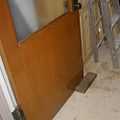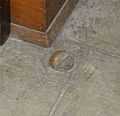Doorstop

A doorstop (also door stopper or door stop) is an object or device used to hold a door open or closed, or to prevent a door from opening too widely. Alternatively, a doorstop can be a thin slat built inside a door frame to prevent a door from swinging through when closed. A door stop (applied) may also be a small bracket or 90 degree piece of metal applied to the frame of a door to stop the door from swinging (bi-directional) and converting that door to a single direction (in-swing push or out-swing pull).
Usage
Holding doors open
A door may be stopped by a door stop which is simply a heavy solid object, such as a rubber, placed in the path of the door. These stops are predominantly improvised. Historically, lead bricks have been popular choices when available. However, as the toxic nature of lead has been revealed, this use has been strongly discouraged.
Another method is to use a door stop which is a small wedge of wood, rubber, plastic, cotton or another material. Manufactured wedges of these materials are commonly available. The wedge is kicked into position and the downward force of the door, now jammed upwards onto the doorstop, provides enough static friction to keep it motionless.
A third strategy is to equip the door itself with a stopping mechanism. In this case, a short metal bar capped with rubber, or another high friction material, is attached to a hinge near the bottom of the door opposite the door hinge and on the side of the door which is in the direction that it closes. When the door is to be kept open, the bar is swung down so that the rubber end touches the floor. In this configuration, further movement of the door towards being closed increases the force on the rubber end, thereby increasing the frictional force which opposes the movement. When the door is to be closed, the stop is released by pushing the door slightly more open which releases the stop and allows it to be flipped upwards. A newer version of equipping the door with the stopping mechanism is to attach a magnet to the bottom of the door on the side which opens outward which then latches onto another magnet or magnetic material on the wall or a small hub on the floor. The magnet must be strong enough to hold the weight of the door, but weak enough to be easily detached from the wall or hub.
-

A metal brick used as a door stop
-

A commercially available rubber door stop
-

A door mounted door stop
-

An elephant in the doorway
Preventing damage by doors
Another type of doorstop is used to prevent doors from opening too far and damaging nearby walls. In this case a rubber cylinder or dome, or a rod or block of rubber-tipped metal, wood or plastic, is screwed into the wall or the floor in the path of the door. If it is attached to the wall it may be either a few inches above the ground, or at such a height as to meet the doorknob. A short wall-attached doorstop, usually a rubber dome or cylinder, is sometimes called a wall bumper.
On occasion, stops are used that are fitted at the midpoint of the door, as part of the central door-hinge. Such a stop is known as a "hinge stop".
-

A doorknob-blocking wall mounted door stop, also called a "wall bumper"
-

A floor mounted door stop
-

The consequence of lacking a door stop
Dialect usage
In various British English dialects including those in the south-west, north-east and north-west of England, the word "doorstop" is cognate with "doorstep" in standard English, being derived from door + stoop.
| Wikimedia Commons has media related to Doorstops. |